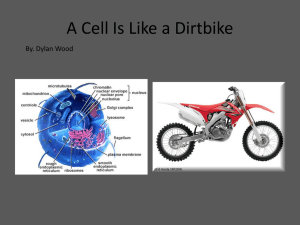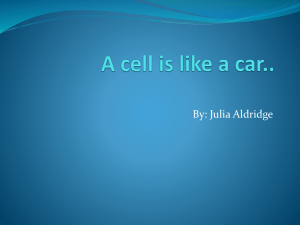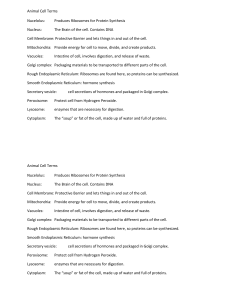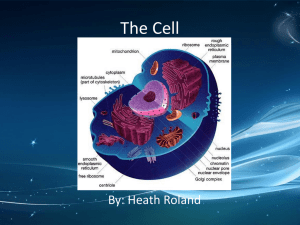Bio Ch. 7 practice test ANSWERS
advertisement
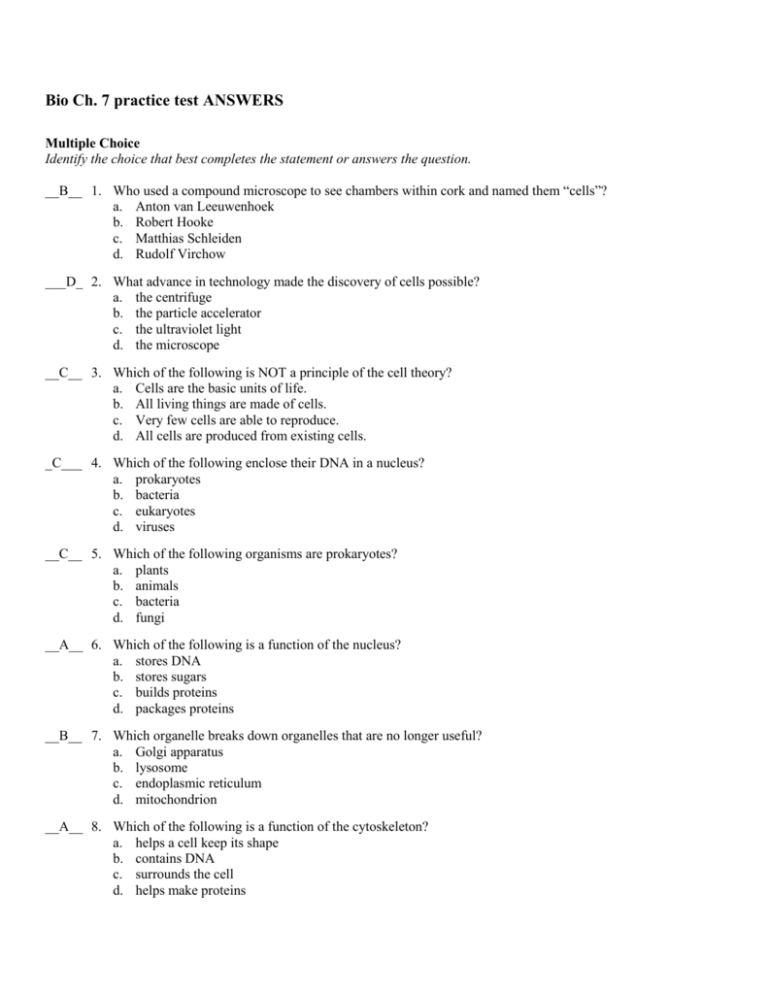
Bio Ch. 7 practice test ANSWERS Multiple Choice Identify the choice that best completes the statement or answers the question. __B__ 1. Who used a compound microscope to see chambers within cork and named them “cells”? a. Anton van Leeuwenhoek b. Robert Hooke c. Matthias Schleiden d. Rudolf Virchow ___D_ 2. What advance in technology made the discovery of cells possible? a. the centrifuge b. the particle accelerator c. the ultraviolet light d. the microscope __C__ 3. Which of the following is NOT a principle of the cell theory? a. Cells are the basic units of life. b. All living things are made of cells. c. Very few cells are able to reproduce. d. All cells are produced from existing cells. _C___ 4. Which of the following enclose their DNA in a nucleus? a. prokaryotes b. bacteria c. eukaryotes d. viruses __C__ 5. Which of the following organisms are prokaryotes? a. plants b. animals c. bacteria d. fungi __A__ 6. Which of the following is a function of the nucleus? a. stores DNA b. stores sugars c. builds proteins d. packages proteins __B__ 7. Which organelle breaks down organelles that are no longer useful? a. Golgi apparatus b. lysosome c. endoplasmic reticulum d. mitochondrion __A__ 8. Which of the following is a function of the cytoskeleton? a. helps a cell keep its shape b. contains DNA c. surrounds the cell d. helps make proteins ___C_ 9. Which structures are involved in cell movement? a. cytoplasm and ribosomes b. nucleolus and nucleus c. microtubules and microfilaments d. chromosomes __D__ 10. Which structure makes proteins using coded instructions that come from the nucleus? a. Golgi apparatus b. mitochondrion c. vacuole d. ribosome __A__ 11. Which sequence correctly traces the path of a protein in the cell? a. ribosome, endoplasmic reticulum, Golgi apparatus b. ribosome, endoplasmic reticulum, chloroplast c. endoplasmic reticulum, lysosome, Golgi apparatus d. ribosome, Golgi apparatus, endoplasmic reticulum __A__ 12. Which organelles are involved in energy conversion? a. mitochondria and chloroplasts b. mitochondria and ribosomes c. smooth and rough endoplasmic reticulum d. Golgi apparatus and chloroplasts __C__ 13. Which organelle would you expect to find in plant cells but not animal cells? a. mitochondrion b. ribosome c. chloroplast d. smooth endoplasmic reticulum __B__ 14. You will NOT find a cell wall in which of these kinds of organisms? a. plants b. animals c. fungi d. bacteria __B__ 15. Which of the following structures serves as the cell’s boundary from its environment? a. mitochondrion b. cell membrane c. chloroplast d. channel protein __D_ 16. Which of the following is a function of the cell membrane? a. breaks down lipids, carbohydrates, and proteins from foods b. stores water, salt, proteins, and carbohydrates c. keeps the cell wall in place d. regulates the movement of materials into and out of the cell __B__ 17. The diffusion of water across a selectively permeable membrane is called a. osmotic pressure. b. osmosis. c. pinocytosis. d. active transport. __A__ 18. An animal cell that is surrounded by fresh water will burst because the osmotic pressure causes a. water to move into the cell. b. water to move out of the cell. c. solutes to move into the cell. d. solutes to move out of the cell. ____D 19. Which means of particle transport requires input of energy from the cell? a. diffusion b. osmosis c. facilitated diffusion d. active transport Figure 7–5 __A__ 20. Which means of particle transport is shown in Figure 7–5 above? a. endocytosis b. exocytosis c. facilitated diffusion d. protein pump __C__ 21. Which of the following activities is NOT a way that unicellular organisms maintain homeostasis? a. reproduction b. growth c. cell specialization d. response to the environment __B__ 22. Which term describes the relatively constant internal physical conditions of an organism? a. b. c. d. cell specialization homeostasis organ system unicellularity __A__ 23. Which of the following is an example of an organ? a. heart b. epithelial tissue c. digestive system d. nerve cell __C__ 24. A group of similar cells that perform a particular function is called a. an organ. b. an organ system. c. a tissue. d. a division of labor. ___A_ 25. Which list represents the levels of organization in a multicellular organism from the simplest level to the most complex level? a. cell, tissue, organ system, organ b. organ system, organ, tissue, cell c. tissue, organ, organ system, cell d. cell, tissue, organ, organ system Modified True/False Indicate whether the statement is true or false. If false, change the identified word or phrase to make the statement true. ___F_ 1. A scanning electron microscope allows light to pass through a specimen and focuses it using two lenses to form an image. _____LIGHT MICROSCOPE____________________ __F__ 2. Cilia and flagella are made of protein filaments called endoplasmic reticulum. ____MICROTUBULES_____________________ __F__ 3. Plant cells have chloroplasts but not mitochondria. __________HAVE_______________ __T__ 4. Moving materials from an area of low concentration to an area of high concentration requires active transport. _________________________ ___T_ 5. There is a division of labor among the cells of multicellular organisms. _________________________ Short Answer 1. What does the cell theory say? Figure 7–8 2. Is the cell in Figure 7–8 above a prokaryote or a eukaryote? What features help you determine your answer? 3. Explain, in terms of osmosis, why a raisin placed in a cup of pure water overnight will puff up with water. 4. List the four levels of organization in a multicellular organism in order from simplest to most complex. Science Skills Figure 7–11 HINTS: CELL I IS AN ANIMAL CELL, CELL II IS A PLANT CELL N= chloroplast I= cell membrane, L=cell membrane (inside of the cell wall J) O=central vacuole E and K are nucleus 1. Interpret Visuals Which drawing in Figure 7–11, I or II, contains structures that carry out photosynthesis? What is this structure labeled in the diagram? 2. Compare and Contrast Look at Figure 7–11. Which structure in drawing I corresponds to structure L in drawing II? What is the name of this structure? 3. Compare and Contrast Which three structures are found in drawing II of Figure 7–11 but not in drawing I? What are the names of these structures? 4. Interpret Visuals Which organelle is labeled K in Figure 7–11? What is the function of this organelle? 5. Interpret Visuals Do the drawings in Figure 7–11 represent prokaryotes or eukaryotes? How do you know?
